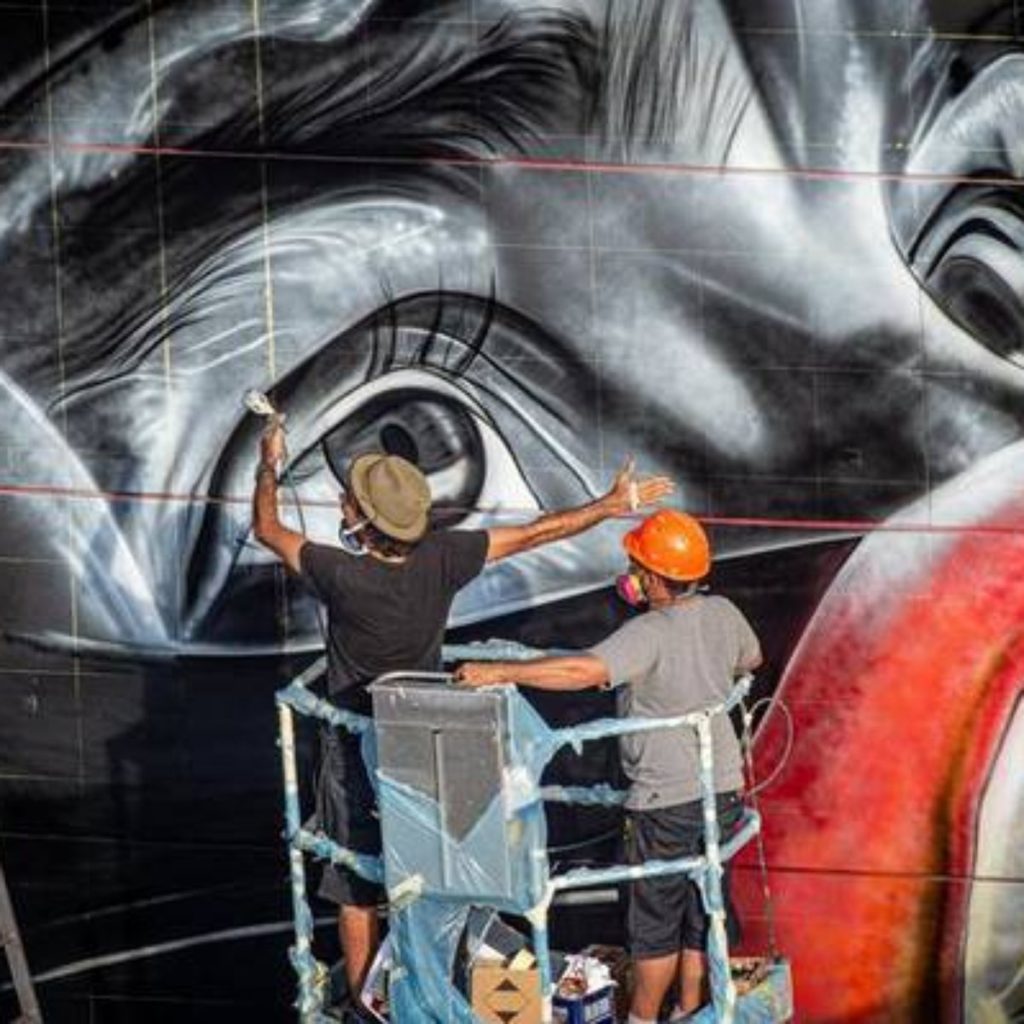Brasileiro Eduardo Kobra conquista mundo com mural a céu aberto
editoria@floridareview.com

Famoso por suas obras com tema de caleidoscópio, cores vivas e linhas arrojadas, o artista brasileiro Eduardo Kobra já realizou mais de 500 trabalhos, nos cinco continentes do mundo, em países como Espanha, Itália, Noruega, Inglaterra, Malawi, Índia, Japão e Emirados Árabes Unidos, além de várias cidades nos Estados Unidos.
Desde os Jogos Olímpicos Rio 2016, Kobra detém o recorde do Maior grafite do mundo, registrado no Guiness Book, com três mil metros quadrados, no Rio de Janeiro.
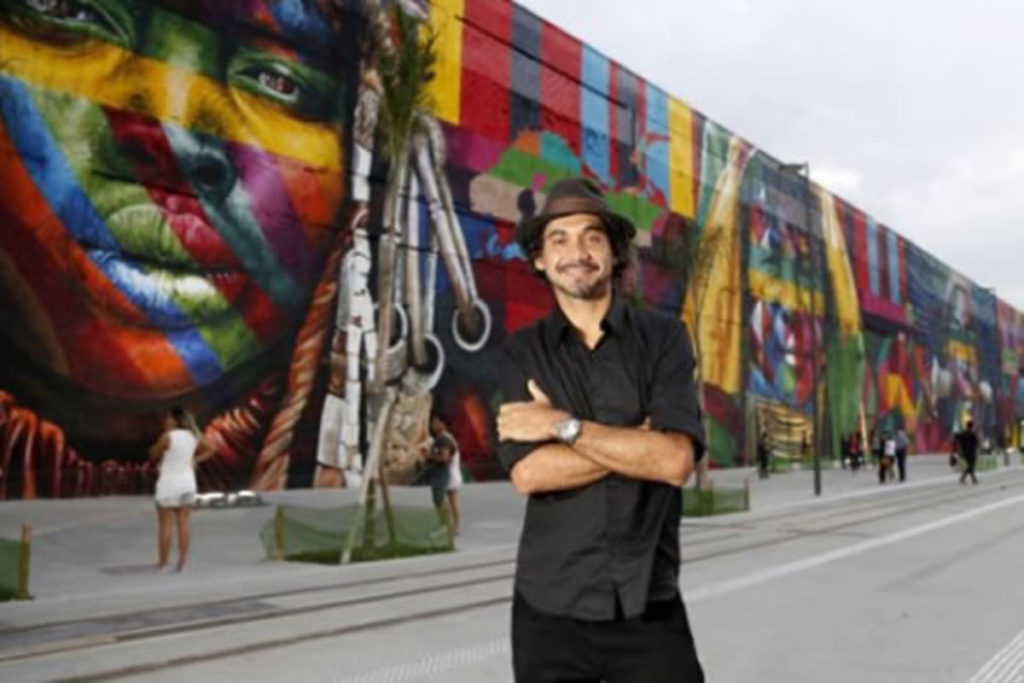
A marca foi superada pelo próprio artista em 2017, em um paredão de quase seis mil metros quadrados, às margens da Rodovia Castello Branco, na cidade de Itapevi, região metropolitana de São Paulo. Inspirada em uma fotografia de Lailson Santos, presente no livro O cacau é show, o painel relata as origens do cacau brasileiro.
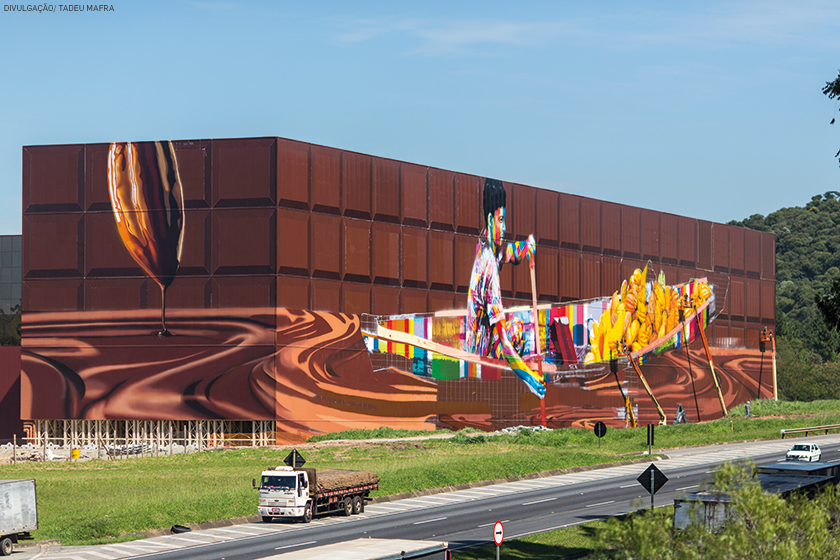
O artista nos fala, em entrevista, sobre seu processo de criação, escolha de voluntários, restaurações, entre outros:
FR – Como funciona o processo de criação de um grande mural? Desde o projeto à execução, quais habilidades, além de talento, são exigidas?
Kobra – Depende de vários fatores. Como hoje atuo nos cinco continentes, existem processos em cada cidade, em cada país, em cada continente, que mudam muito, de um lugar para outro.
Além do desenho em si, feito primeiro num papel, depois numa tela e, só depois, passa para o muro. Ou seja, para cada mural feito, muitas vezes, eu faço dez, 20 testes primeiro.
Então, existe todo um estudo. Esse estudo tem a ver com o formato do mural, tem a ver com o local aonde o mural está inserido. Ou seja, as características da região, da arquitetura, do paisagismo, a história do local. Tudo isso acaba influenciando também no meu trabalho.
Existem as permissões do Governo, da cidade, que são bem complexas. Existem as questões de segurança do trabalho, dos registros, da documentação.
Em alguns locais, só pode trabalhar à noite, outros de dia. Então, tem uma variação muito grande e isso muda muito de acordo com quem está convidando também.
Não é só a questão da pintura em si. A parte logística, muitas vezes, é muito mais complexa que a pintura.
FR – Você tem grande parte do trabalho feito sob encomenda. Ainda mantém obras espontâneas?
Kobra – Na realidade, é o contrário. A maioria das minhas obras são feitas de forma espontânea e voluntária. Como eu não tenho nenhum tipo de patrocínio, nem de apoio fixo, quando alguém quer contratar o meu trabalho, tem que me deixar totalmente livre para fazer a arte que eu quero. Ou seja, não são eles que sugerem, eu é que mostro as possibilidades.
Então, eu posso pintar prédios em Nova York, Miami, posso pintar em São Paulo, em Londres, contanto que isso faça sentido dentro do meu segmento, dentro das minhas áreas de pesquisa, dentro das mensagens que eu costumo trabalhar, costumo abordar.
E não me desvio disso por dinheiro, não me desvio disso com marcas também, ou possíveis apoiadores que vão contra minhas filosofias de visão de mundo, de cultura, de proteção de animais, de meio ambiente.
FR – Qual é a sensação de fazer uma arte que pode ser permanente, se mantida pelo proprietário do muro, ou transitória, se apagada, como aconteceu com O Muro das Memorias, em São Paulo?
Kobra – A arte de rua, pela sua natureza, é efêmera. Eu comecei a pintar nas ruas e 90%, ou mais, em um acervo de mais de três mil fotos de trabalho, desde 1987, foi apagada ou removida.
Quando se é mais jovem, é mais tranquilo lidar com isso. Hoje eu tenho outros valores, então eu acredito que essa conduta tem que ser repensada, porque existem obras de arte fantásticas, feitas por artistas do mundo inteiro nas ruas, nos muros e tudo mais pelas cidades. Eu acho que isso não pode ser simplesmente removido.
Acho que os muros têm que receber uma preparação especial, tem que receber uma aplicação de verniz, têm que receber um cuidado periódico, pra que as próximas gerações possam ter contato com esses painéis.
Eu acho que a arte de rua ficou e está consagrada como um movimento de arte, um dos mais importantes do século, então acho que é importante ser preservado. É claro que o que o tempo apaga, a fotografia eterniza.
FR – Por serem obras a céu aberto, intempéries, como sol, chuva, entre outros, podem desgastar ou mesmo destruí-las. Você já fez algum trabalho de restauração das suas próprias obras?
Kobra – Excelente essa pergunta. Justamente, estou com um projeto agora de revitalizar e restaurar murais ao redor do mundo. Estou começando por São Paulo, já restaurei quatro ou cinco painéis. Eu tenho mais de 30 na cidade.
Eu acho que além de fazer novos murais, como respondi na pergunta anterior, é importante também manter esses murais que já existem. Porque muitos deles são feitos com uma certa urgência, uma certa correria, às vezes a parede não é preparada adequadamente e, óbvio, como os murais estão na rua, o excesso de sol, o frio intenso, maresia, tudo isso interfere na tinta, há um desgaste natural, mas acho que de tempos em tempos é necessário sim fazer uma manutenção desses muros.
Então tenho feito isso, com meu time, pra fazer perdurarem por mais tempo os muros pelas cidades, pra dar esse benefício para as próximas gerações, assim como eu queria que meu filho visse tantos murais como do Banksy, tantas coisas bacanas, que acabam se perdendo aí no tempo, ou, até mesmo, pro vandalismo.
FR – Qual a média de tempo você leva para finalizar um mural como o do teatro Adrienne Arsht Center, em Miami?
Kobra – O tempo que se leva pra produzir um mural também está ligado a questões da qualidade da parede, do tipo de textura, se é vidro, se é madeira, se é plástico, se é concreto. Tudo isso interfere no tipo de material e no tipo de técnica.
Também tem outros elementos que interferem, como a questão de altura. Por exemplo, se é no alto de um prédio, eu já cheguei a pintar prédios de até 100 metros de altura e fazer murais de até seis mil metros de comprimento.
Então, cada trabalho oferece um desafio diferente.
FR – Qual a média de ajudantes que você precisa para um mural no mesmo tipo de arte?
Kobra – Eu criei um projeto chamado Envolva-se, no qual as pessoas se cadastram, de várias cidades ao redor do mundo, de qualquer lugar do mundo, demonstrando qualquer interesse de participar como voluntários.
É claro que não é qualquer trabalho que dá pra participar. Mas, pra entender a técnica, pra preencher fundos, pra estar junto com a gente.
Quando vou a determinadas cidades, eu pego meu arquivo e procuro pessoas que estão naquela localidade, envio as mensagens pra elas e elas podem vir participar com a gente.
Sobre a equipe, meu estúdio é muito pequeno, tem uma parte de escritório, que tem quatro pessoas, mais ou menos, e a parte de produção em si, no qual estou envolvido em todos os projetos diretamente em todos os processos, principalmente na criação e na pintura, obviamente, mas existem dois meninos, que estão sempre comigo que é o Aguinaldo e o Marcos, e em outras ocasiões, quando o muro é muito grande, eu acabo envolvendo mais pessoas, ou até alguns assistentes locais, pra ter uma troca com artistas locais, pra fazer partes não essenciais da obra, ou seja, fundos e preparação de tinta e auxiliar na montagem e desmontagem de equipamentos, algumas coisas nesse sentido.
FR – O que te inspira nos seus processos de criação?
Kobra – Eu tenho o meu próprio caminho nos processos de criação. Eu costumo falar que eu gosto de pintar com meu próprio pincel!
Então, meus muros não são apenas uma questão estética, todos têm um objetivo de passar uma mensagem, seja de respeito, de tolerância, de paz, de união dos povos, recortes da história, memória, proteção dos animais e do meio ambiente.
Tem umas questões que me incomodam, como intolerância, que acabam, em algum momento, virando um desenho em um papel, pesquisas, visitas a museus, a galerias, eu gosto de investigar e pesquisar tudo, mergulhar em cada um dos temas e fazer pesquisas, pintar esses originais e, no momento oportuno, acabar pintando murais ao redor do mundo.
Mas, em todos os murais que são feitos, sempre existe uma tela, que é o protótipo original do mural.
No ano passado, eu fiz uma exposição com mais de 40 dessas obras nos Estados Unidos.
Estados Unidos
Em 2015, Eduardo Kobra e sua equipe pintaram seis murais, durante 23 dias, na Florida: Hamlet, para o Canvas Outdoor Museum Show, em Palm Beach, Einstein vai à praia, em West Palm Beach, Sopa de Letrinhas, em Sarasota, além de participação no Art Basel, festival de arte urbana em Wynwood, bairro de Miami.
No festival, Kobra apresentou três obras: O anjo caído, em referência aos graves problemas do nosso planeta, como guerras, terrorismo e às agressões ao clima, Dê uma chance à paz, inspirado na clássica cena de John Lennon e Yoko Ono, e Stop Wars, com a estampa do personagem Yoda, do filme clássico Guerra nas Estrelas.
Em 2019, o artista expôs 27 peças, incluindo novas pinturas dos últimos murais do artista, servindo como tributos a suas obras de grande escala, no Goldman Global Arts (GGA) Gallery, galeria de arte localizada dentro do bairro Wynwood Walls, em Miami.
A coleção exposta, que conta com obras como Salvador Dalí e Peace Between Nations – além de Frida Kahlo e Diego Rivera, entre outras figuras notáveis, como Nelson Mandela e da princesa Diana – foi quase totalmente vendida antes mesmo das portas se abrirem, consolidando o sucesso do brasileiro.
Contudo, essa não foi a primeira vez que o muralista mostrou seu trabalho na cidade americana.
Wynwood Walls fez sua primeira parceria com Kobra durante a Art Basel 2018, onde pintou o Ethnicities, mural feito em contêineres representando cinco crianças de cinco continentes, com a beleza e diversidade das diferentes culturas e uma mensagem universal de esperança para o futuro.
Em novembro de 2018, o artista foi convidado para pintar a bailarina Itzkab Barbosa, estudante do Miami City Ballet, na torre do teatro Adrienne Arsht Center, em Downtown.
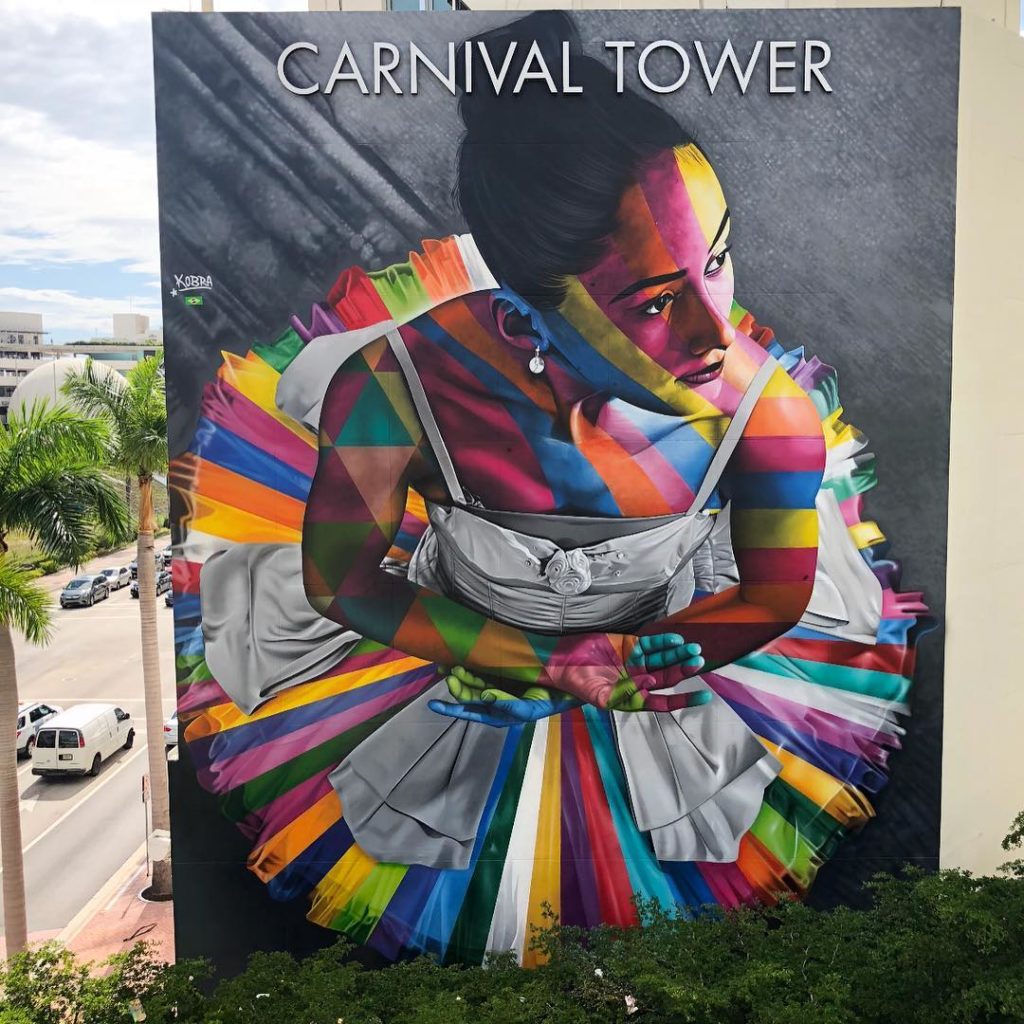
Sobre Eduardo Kobra
O artista nasceu em São Paulo, no bairro Jardim Martinica, onde começou sua carreira como pichador, para depois se tornar grafiteiro e, ainda no começo, o artista colecionava advertências por intervenções não autorizadas na escola e chegou a ser detido três vezes por crime ambiental – justamente por conta do uso irregular de sprays em muros das redondezas.
Em 2007, Kobra ganhou notoriedade a partir de O Muro das Memórias, na Avenida 23 de Maio – uma celebração aos 455 anos da cidade de São Paulo.
O mural, de mil metros quadrados, retratava distintos senhores e senhoras de chapéu em tons preto, branco e cinza, que representavam os imigrantes oriundos de diversas partes do mundo.
No entanto, a obra foi apagada, em 2017, com a justificativa de ter sido vandalizada.
Mesmo após ter seu trabalho espalhado pelo mundo inteiro, Eduardo Kobra não deixa suas origens para traz e mantém, em sua equipe, jovens da periferia paulista. Além de manter seu ateliê e residência na cidade.
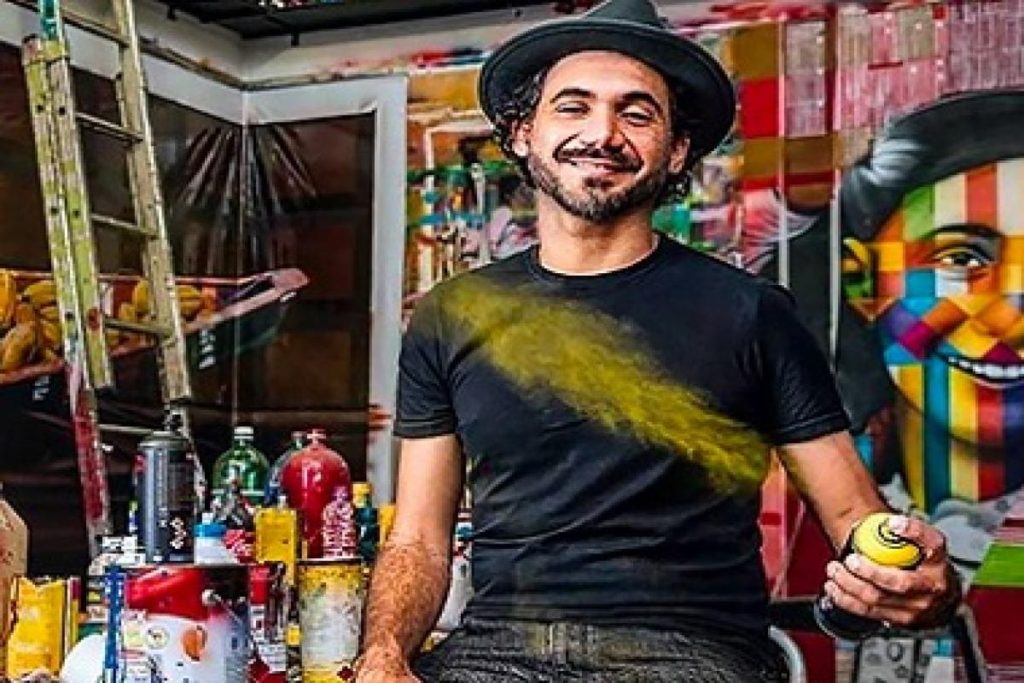
From the outskirts of São Paulo to the world
Brazilian Eduardo Kobra conquers the world with an open-air mural

Famous for his works with a kaleidoscope theme, vivid colors and bold lines, the Brazilian artist Eduardo Kobra has already done more than 500 works, in the five continents of the world, in countries like Spain, Italy, Norway, England, Malawi, India, Japan, and United Arab Emirates, as well as several cities in the United States.
Since the Rio 2016 Olympic Games, Kobra has held the record for the largest graffiti in the world, registered in the Guinness Book, with three thousand square meters, in Rio de Janeiro.
The mark was surpassed by the artist himself in 2017, on a wall of almost six thousand square meters, on the banks of the Castello Branco Highway, in the city of Itapevi, in the metropolitan region of São Paulo. Inspired by a photograph by Lailson Santos, featured in the book O cacau é show, the panel reports on the origins of Brazilian cacao.
The artist tells us, in an interview, about his creation process, choice of volunteers, restorations, among others:
FR – How does the process of creating a large mural work? From design to execution, what skills, in addition to talent, are required?
Kobra – It depends on several factors. Like today I work in the five continents, there are processes in every city, in every country, on every continent, which changes much from one place to another.
In addition to the drawing itself, done first on paper, then on a canvas, and only then goes on to the wall. That is, for each mural done, I often do ten, 20 tests first.
So, there is a whole study. This study has to do with the format of the mural, it has to do with the place where the mural is inserted. That is the characteristics of the region, the architecture, the landscaping, the history of the place. All of this ends up influencing my work as well.
There are government permits, from the city, which are very complex. There are issues of job security, records, documentation.
In some places, you can only work at night, others during the day. So, there is a lot of variation and this changes a lot according to who is also inviting.
Not only is the issue of painting itself. The logistics part is often much more complex than painting.
FR – You have a great deal of custom work. Do you still have spontaneous works?
Kobra – In reality, it is the opposite. Most of my work is done spontaneously and voluntarily. Since I don’t have any kind of sponsorship or fixed support, when someone wants to hire my work, they have to leave me free to make the art I want. In other words, they are not the ones who suggest it, I am the one who shows the possibilities.
So, I can paint buildings in New York, Miami, I can paint in São Paulo, London, as long as it makes sense within my segment, within my research areas, within the messages that I usually work with, I usually address.
And I don’t deviate from it for money, I don’t deviate from it with brands too, or possible supporters who go against my philosophies of worldview, culture, animal protection, the environment.
FR – How does it feel to make art that can be permanent, if maintained by the owner of the wall, or transitory, if erased, as happened with O Muro das Memorias, in São Paulo?
Kobra – Street art, by its nature, is ephemeral. I started painting on the streets and 90%, or more, in a collection of more than three thousand work photos, since 1987, has been erased or removed.
When you’re younger, it’s easier to deal with it. Today I have other values, so I believe that this conduct has to be rethought, because there are fantastic works of art, made by artists from all over the world on the streets, on the walls and everything else in the cities. I think that this cannot be simply removed.
I think the walls have to receive special preparation, they have to receive a varnish application, they have to receive periodic care so that the next generations can have contact with these panels.
I think that street art stayed and is enshrined as an art movement, one of the most important of the century, so I think it is important to be preserved. It is clear that what time erases, photography eternalizes.
FR – Because they are work in the open, weather conditions, such as sun, rain, among others, can wear out or even destroy them. Have you done any work to restore your works?
Kobra – Excellent question. Precisely, I have a project now to revitalize and restore murals around the world. I’m starting in São Paulo, I’ve already restored four or five panels. I have over 30 in the city.
I think that in addition to making new murals, as I answered in the previous question, it is also important to maintain these murals that already exist. Because many of them are made with a certain urgency, a certain rush, sometimes the wall is not prepared properly and as the murals are on the street, the excess of sun, the intense cold, the salt air, all these interfere with the paint, there are natural wear and tear, but I think that from time to time it is necessary to maintain these walls.
So I have done this, with my team, to make the walls last longer in the cities, to give this benefit to the next generations, just as I wanted my son to see as many murals as Banksy’s, so many cool things, that end up becoming losing there in time, or even to vandalism.
FR – How long does it take you to finish a mural like the one at the Adrienne Arsht Center in Miami?
Kobra – The time it takes to produce a mural is also linked to issues of wall quality, the type of texture, whether it is glass, whether it is wood, whether it is plastic, whether it is concrete. All of this interferes with the type of material and the type of technique.
Other elements interfere, such as the height issue. For example, if it is at the top of a building, I have already painted buildings up to 100 meters high and made murals up to six thousand meters long.
So, each job offers a different challenge.
FR – What is the average number of helpers you need for a mural in the same type of art?
Kobra – I created a project called Get Involved, in which people register, from various cities around the world, from anywhere in the world, showing any interest in participating as volunteers.
Of course, it’s not just any job you can participate in. But, to understand the technique, to fill funds, to be together with us.
When I go to certain cities, I take my file and look for people who are in that location, send messages to them and they can come and participate with us.
About the team, my studio is very small, it has an office part, which has four people, more or less, and the production part itself, in which I am involved in all projects directly in all processes, mainly in the creation and in painting, obviously, but there are two boys, who are always with me who are Aguinaldo and Marcos, and on other occasions, when the wall is very big, I end up involving more people, or even some local assistants, to have an exchange with local artists, to make non-essential parts of the work, that is, funds and preparation of paint and assist in the assembly and disassembly of equipment, some things in this sense.
FR – What inspires you in your creative processes?
Kobra – I have my path in the creative process. I usually say that I like to paint with my brush!
So, my walls are not just an aesthetic issue, they all have the objective of sending a message, be it respect, tolerance, peace, unity of peoples, cuts in history, memory, protection of animals and the environment.
Some issues bother me, like intolerance, that end up, at some point, becoming a drawing on paper, research, visits to museums, galleries, I like to investigate and research everything, dive into each of the themes and do research , paint these originals and, in due course, end up painting murals around the world.
But, in all the murals that are made, there is always a canvas, which is the original prototype of the mural.
Last year, I did an exhibition with more than 40 of these works in the United States.
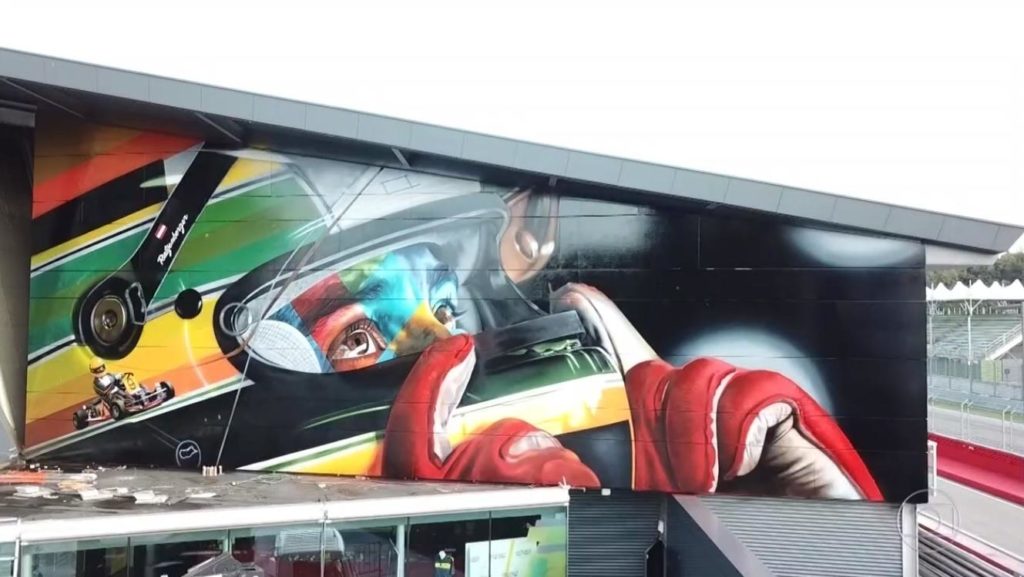
United States
In 2015, Eduardo Kobra and his team painted six murals, during 23 days, in Florida: Hamlet, for the Canvas Outdoor Museum Show, in Palm Beach, Einstein goes to the beach, in West Palm Beach, Alphabet Soup, in Sarasota, besides participation in Art Basel, an urban art festival in Wynwood, Miami.
At the festival, Kobra presented three works: The fallen angel, about the serious problems of our planet, such as wars, terrorism and the aggressions to the climate, Give peace a chance, inspired by the classic scene of John Lennon and Yoko Ono, and Stop Wars, with the character Yoda, from the classic movie Star Wars.
In 2019, the artist exhibited 27 pieces, including new paintings from the artist’s latest murals, serving as tributes to his large-scale works at the Goldman Global Arts (GGA) Gallery, an art gallery located within Miami’s Wynwood Walls neighborhood.
The exhibited collection, which features works such as Salvador Dalí and Peace Between Nations – in addition to Frida Kahlo and Diego Rivera, among other notable figures, such as Nelson Mandela and Princess Diana – was almost totally sold even before the doors opened, consolidating the success of the Brazilian.
However, this was not the first time that the muralist showed his work in the American city.
Wynwood Walls made her first partnership with Kobra during Art Basel 2018, where she painted Ethnicities, a mural made in containers representing five children from five continents, with the beauty and diversity of different cultures and a universal message of hope for the future.
In November 2018, the artist was invited to paint the ballerina Itzkab Barbosa, student of the Miami City Ballet, in the tower of the Adrienne Arsht Center theater, in Downtown.
About Eduardo Kobra
The artist was born in São Paulo, in the Jardim Martinica neighborhood, where he began his career as a graffiti artist, and later became a graffiti artist. – precisely because of the irregular use of sprays on nearby walls.
In 2007, Kobra gained notoriety from O Muro das Memórias, on Avenida 23 de Maio – a celebration at the age of 455 in the city of São Paulo.
The thousand-square-meter mural depicted different men and women wearing hats in black, white and gray,ones, representing immigrants from different parts of the world.
However, the work was erased in 2017 because it was vandalized.
Even after having his work spread all over the world, Eduardo Kobra does not leave his origins behind and keeps, in his team, young people from the São Paulo periphery. In addition to maintaining his studio and residence in the city.

